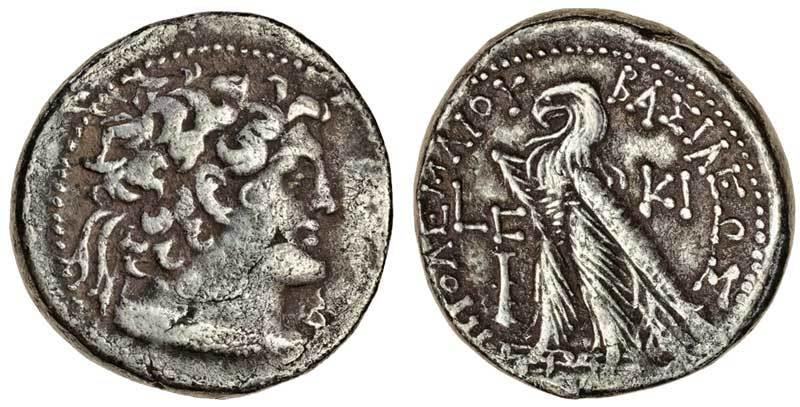H 324 - Citium (Ptolemy X), silver, tetradrachms (113-109 BCE) Nicolaou - Mørkholm
From SILVER
(Redirected from H 324 - Citium (Ptolemy X), silver, tetradrachms (113-109 BCE))
113 BCE - 109 BCE Silver 2,019 kg
Description
| ObverseInscription or printing placed on the obverse.: | Head of Ptolemy X Alexander I right, wearing diadem. |
| ReverseInscription or printing placed on the reverse.: | ΒΑΣΙΛΕΩΣ ΠΤΟΛΕΜΑΙΟΥ (Greek).Eagle standing to left on thunderbolt, with wings closed and sceptre at shoulder, L (date) to left, KI to right. |
Mint and issuing power
| MintIdentifies the place of manufacture or issue of a numismatic object.: | Citium | Ancient regionAncient region.: | Cyprus | Modern countryModern country: Greece | AuthorityIdentifies the issuing power. The authority can be "pretended" when the name or the portrait of X is on the coin but he/she was not the issuing power. It can also be "uncertain" when there is no mention of X on the coin but he/she was the issuing power according to the historical sources: | Ptolemaic dynasty (323-30 BC), Ptolemy X Alexander I (Ptolemaic king, 110-88 BC) |
Chronology
| FromIdentifies the initial date in a range assigned in a numismatic context. | 113 BCE | toIdentifies the final date in a range assigned in a numismatic context.. | 109 BCE | PeriodTime period of the numismatic object.: Hellenistic 323-30 BC |
Physical description
| MetalThe physical material (usually metal) from which an object is made.: | Silver |
Median weightMedian of the weights of numismatic objects (in grams). in grams | 14.10 | DenominationTerm indicating the value of a numismatic object. Examples: tetradrachm, chalkous, denarius.: | tetradrachm |
StandardStandard.: | Ptolemaic |
Image

H 324 Citium Ptolemy X Tetradrachm 113-109.jpg [1]
References
| Die study referencePublication of the study: | Nicolaou - Mørkholm 19761Nicolaou - Mørkholm 1976 | ||
| Coin series referenceReference to coin series study: | RQEMH2RQEMH, n° 324 | ||
Obverse dies distribution
| FrequencyFrequency of specimen in distribution. ᵖ | Number of obversesNumber of obverse dies. ᵖ (o) | % (o) | Number of coinsNumber of coins. (n) | % (n) | Die nameName(s) of the die(s). |
| 1 | 3 | 42.86 | 3 | 4.62 | 73, 76, 78 |
| 6 | 1 | 14.29 | 6 | 9.23 | 74 |
| 8 | 1 | 14.29 | 8 | 12.31 | 77 |
| 24 | 2 | 28.57 | 48 | 73.85 | 72, 75 |
| Total | 7 of 7 | 100.01 | 65 of 65 | 100.01 |
Reverse dies distribution
no distribution is available
Quantification
| Number of obversesNumber of obverse dies. ᵖ (o) | 7 | Number of singletons (o1)The number of singleton coins. ᵖ | 3 |
| Number of reverse diesNumber of reverse dies. (r) | 48 | Number of coinsNumber of coins. (n) | 65 |
| Coins per obverse dieNumber of coins per obverse die. (n/o) | 9.29 | Coins per reverse dieNumber of coins per reverse die. (n/r) | 1.35 |
| Reverse per obverse ratioRatio of obverse dies divided by reverse dies. (r/o) | 6.86 | Percentage of singletons (o1)number of coins (n) divided by the number of singletons (o1) ᵖ | 42.86 % |
| Original number of dies (O) (Carter 1983 formula)The estimation of the number of coins according to Carter 1983 ᵖ | 7.16 | Coins struck if 20,000 as average productivity per dieCoins made if the average productivity for obverses (according to Carter) is 20,000. ᵖ | 143,200 |
| Original number of dies (O) (Esty 2011 formula)The estimation of the number of coins according to the singleton formula in Esty 2011 ᵖ (O) | 7.84 | Survival rate if 20,000 as average productivity per dieSurvival rate if average productivity is 20,000. ᵖ | 0.00045 |
| Coverage (o = % of O) (Esty 1984 formula)Esty 1984 - coverage (% of O) ᵖ (o = % of O) | 95.38% | Die productivity if survival rate 1/2,000Average productivity if survival rate is 1/2,000. ᵖ | 18,156.42 |
| Weight of silver (in kg) if 20,000 coins per die (O = Carter formula)Carter 1983 * Median weight * 20000 (*10 if gold or electrum) ᵖ | 2,019 kg <br /> 2,019 kg | Die productivity if survival rate 1/5,000Average productivity if survival rate is 1/5,000. ᵖ | 45,391.06 |
Remarks
Most likely one single workstation